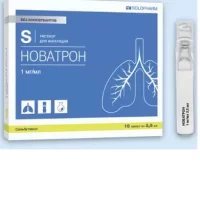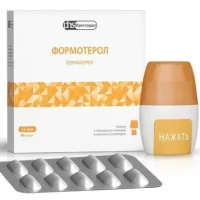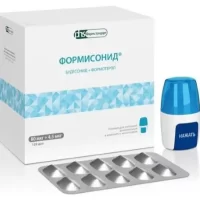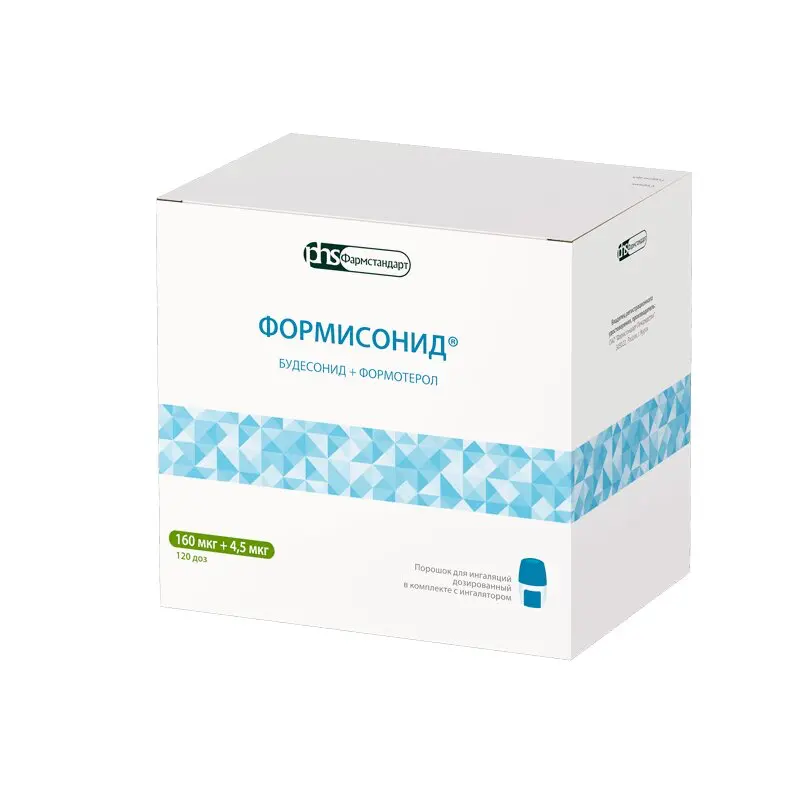Description
Tiotropium Pharmacodynamics
Tiotropium is a long-acting m-cholinoblocker.
It has equal affinity for various muscarinic receptor subtypes from M1 to M5.
Inhibition of M3 receptors in the respiratory tract results in relaxation of smooth muscles. Bronchodilator (bronchodilator) effect lasts for at least 24 hours and depends on the dose of tiotropium bromide. Significant duration of action is probably due to very slow dissociation of tiotropium bromide from M3-receptors compared to ipratropium bromide. When administered by inhalation, tiotropium bromide as N-quaternary anticholinergic agent has a local selective effect, while in therapeutic doses does not cause systemic m-cholinoblocking adverse reactions. Dissociation of tiotropium bromide from M2-receptors is faster than from M3. High affinity for receptors and slow dissociation cause pronounced and prolonged bronchodilator effect in patients with chronic obstructive pulmonary disease (COPD). Bronchodilation after inhalation of tiotropium bromide is a consequence of local rather than systemic effects.
Tiotropium bromide significantly increases lung function (forced expiratory volume in 1 second – FEF1, forced vital capacity of lungs – VEF) 30 minutes after a single dose for 24 hours. Pharmacodynamic equilibrium is achieved within the first week, and a pronounced bronchodilator effect is observed on the third day. Tiotropium bromide significantly increases morning and evening peak expiratory flow rate (PEF). The use of tiotropium bromide within a year does not cause a decrease in the effectiveness with respect to bronchodilation.
Tiotropium bromide significantly reduces dyspnea throughout the treatment period, significantly improves exercise tolerance, significantly reduces the number of COPD exacerbations and increases the time to the first exacerbation, and significantly reduces the number of hospitalizations associated with COPD exacerbations and increases the time to the first hospitalization. Tiotropium bromide leads to a sustained improvement in SPH1 after four years of use with no change in the rate of annual decline in SPH1.
There is evidence of a 16% reduction in the risk of death during treatment with tiotropium bromide and evidence of an increase in the time to first exacerbation with a 17% reduction in the risk of exacerbations when using tiotropium bromide compared with taking salmeterol.
Also, tiotropium bromide increases the time to the first severe (requiring hospitalization) exacerbation and reduces the annual number of moderate or severe (requiring hospitalization) exacerbations.
Indications
Maintenance therapy in patients with COPD, including chronic bronchitis and pulmonary emphysema (maintenance therapy for persistent dyspnea and to prevent exacerbations).
Contraindications
– Hypersensitivity to atropine or its derivatives (including ipratropium and oxytropium) and/or to other components of the drug (in particular to lactose monohydrate, which contains milk protein, in lactase deficiency, lactose intolerance, glucose-galactose malabsorption).
– I trimester of pregnancy.
– Age up to 18 years old.
Dosage and administration
- Tiotropium is administered in the form of inhalations, one capsule daily at a time using Inhaler CDM® inhaler.
- The drug should not be swallowed.
- Tiotropium should not be used more than once a day.
- Elderly and elderly patients and patients with renal or hepatic dysfunction may take Tiotropium in recommended doses. However, close monitoring of patients with moderate or severe renal impairment receiving Tiotropium in combination with other drugs that are mainly excreted by the kidneys is necessary.
- Instructions for use of Inhaler CDM® Inhaler
- The Inhaler CDM® inhaler is a plastic device with a movable top and a retractable capsule compartment, about 6 cm high. “Inhaler CDM®” is a single-dose inhaler that allows you to dose and inhale the drug in very small doses. Tiotropium enters the patient’s airway with the air currents when actively inhaling through the mouthpiece. Tiotropium capsules should only be used with the Inhaler CDM® inhaler to ensure correct dosing.
- The CDM® Inhaler is very easy to use. When using it, you should follow the step-by-step instructions below:
- Step 1.
- Remove the transparent cap from the Inhaler CDM® device
- Step 2.
- Hold the device firmly with one hand and open the capsule compartment with the index finger and thumb of your other hand. To do this, press the “PUSH” in the moving part of the Inhaler CDM® device with your index finger, sliding the compartment to the opposite side.
- Step Z.
- Holding the device with one hand, slide the drug capsule into the compartment slot
- Step 4
- Make sure the capsule is properly inserted in the socket
- Step 5.
- Holding the CDM® Inhaler upright, close the slot with your thumb pressed backward until a click is heard
- Step 6.
- Hold the Inhaler CDM® device strictly vertically.
- Step 7.
- Position the Inhaler CDM® device. To do this, firmly press the mouthpiece so that the arrow marked on the housing disappears beyond the boundaries of the bottom of the device to the top line. Then release the mouthpiece to return it to its original position. In doing so, you will puncture the capsule, opening the access of the medication into the lumen of the mouthpiece.
- Step 8.
- Breathe out before inhaling. Do not exhale through the mouthpiece!
- Step 9.
- Gently squeeze the mouthpiece of the Inhaler CDM® device with your teeth, wrap your lips tightly around it and breathe in deeply and strongly through your mouth. You will hear a vibrating sound inside the capsule compartment as the capsule rotates and disperses the medicine. Hold your breath for about 10 seconds or longer, as long as possible. Remove the device from your mouth. Take a slow exhalation. Then breathe normally.
- The mouthpiece should not be chewed or clenched hard with your teeth!
- Repeat steps 8-9 again to ensure that you inhale a dose of the medication.
- Step 10.
- After the inhalation, open the capsule compartment, remove the capsule, and then close it.
- Warning:
- When inhaling, try not to cover the holes located on the sides of the mouthpiece. This may prevent free air movement inside the inhaler, thereby reducing the dispersion of the capsule contents.
- Do not press on the mouthpiece when inhaling. This may block the movement of the capsule. Always close the Inhaler CDM® tightly with the cap after use to keep the mouthpiece clean. Regularly (once a week) clean the outside of the mouthpiece with a dry cloth.





